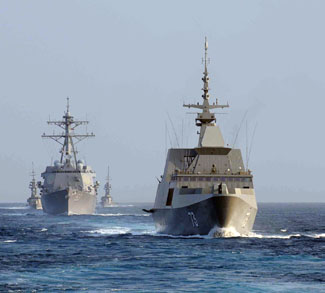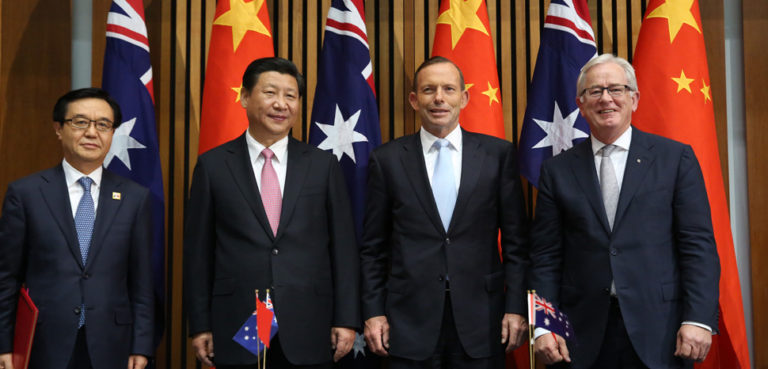Summary
China’s People’s Armed Forces Maritime Militia (PAFMM) evolved out of a military predicament specific to the post-civil war period: How does a government without a formal navy protect its coastline from attack? Fast-forward to the present, and the PAFMM is still being charged with unconventional tasks, though the question has now evolved into: How does a government exert control over a contested body of water without triggering a ‘hot’ war with rival claimants?
This backgrounder explores the history, composition, and tactics of the ‘little blue men’ of China’s littoral waters – the People’s Armed Forces Maritime Militia.
Background
What is the People’s Armed Forces Maritime Militia?
The People’s Armed Forces Maritime Militia (PAFMM) is a pseudo, civilian-military coast guard that engages in ‘gray zone’ operations intended to establish de facto control over disputed waters near China. These operations include providing armed escort for Chinese fishing vessels, intimidating commercial vessels from other nations in disputed waters, and dissuading the coast guards and navies of other claimants from policing their own waters for fear of potential escalation with Beijing.
PAFMM operations are low-intensity and designed to generate acquiescence on the part of rival claimants; in essence, they seek to win the war without a shot being fired. These tactics might involve aggressive forays into waters policed by rival claimants, or more passive ‘rights protection’ missions in waters already firmly within China’s control under the unspoken credo that maritime jurisdiction is merely presence.
For evidence of the success of PAFMM operations overall, one must look no further than the evolving map of the South China Sea.
In keeping with its history as a ‘people’s militia,’ the PAFMM is composed of a mix of maritime workers, who receive military training similar to reserves or national guard and are subsequently eligible to be ‘called up,’ and conventional full-time military recruits. This atypical force composition follows a much more conventional line of command that reaches all the way up to Beijing. Consequently, the US military now views the PAFMM as a branch of the PRC armed forces on the same level as the PLA Navy and China Coast Guard.
Determining the exact size of the PAFMM remains a difficult task due to its vague and shifting membership – fishermen can be ‘drafted’ in and out of the force as the situation demands. Specific details about the militia also rarely make it into official government documents (in fact, the ‘People’s Armed Forces Maritime Militia’ itself is a moniker bestowed by the US Department of Defense). One estimate from US Naval War College expert Andrew S. Erickson puts the number of large vessels at 84. Others have estimated that the PAFMM can leverage as many as three thousand small vessels at any given time. And these numbers can be considered conservative when put in historical context: according to one 1978 estimate, the PAFMM was once composed of 750,000 personnel and 140,000 vessels.
History of the People’s Armed Forces Maritime Militia
The PAFMM’s history stretches back nearly as long as the PRC itself. Comprising mostly of untrained fishermen, the militia was created soon after the civil war. Like the PRC’s ground-based armed forces, the PAFMM followed the Maoist logic of ‘people’s war’; it also intended to solve the more practical problem of shortfalls in naval assets and expertise among the early CCP leadership. The immediate task of the early PAFMM was to defend the mainland from Nationalist incursions. The militia was also employed in attempts to retake coastal islands from the KMT during the 1950s (the first and second Taiwan Strait crises).
But these early forays were just the beginning of the PAFMM’s enduring role in China’s littoral waters. Since its inception, the militia has been a central player in numerous geopolitical stand-offs. In some of these events, the presence of the PAFMM was arguably more decisive than that of the conventional (and historically underfunded) People’s Liberation Army Navy (PLAN). They include:
- Capture of the Paracel Islands from Vietnam in 1974, when the presence of PAFMM vessels – many of them carrying armed crew – helped slow down the South Vietnam government’s decision-making and ultimately deter an armed response. The South China Sea island chain remains under PRC control.
- USNS Impeccable incident in 2009, when PAFMM and PLAN ships swarmed an unarmed US Navy ocean surveillance vessel after it encroached on China’s 200-mile EEZ south of Hainan. The confrontation involved two China-flagged fishing vessels attempting to run over the Impeccable’s sonar equipment and then blocking its path of escape.
- Harassment of Vietnamese survey vessel in 2011, when a Vietnamese seismic survey ship (Binh Minh 02) had its cables cut by Chinese vessels. The incident was notable in its proximity to Vietnam’s coast, taking place just 43 miles southeast of Con Co Island.
- Scarborough Shoal clash in 2012, when the Philippine Navy attempted to board and arrest Chinese fishermen suspected of illegal fishing around Scarborough Shoal, triggering a standoff between Philippine and PLA Navy vessels where Beijing came away the victor. The initial fishing vessels were reportedly PAFMM members who helped coordinate the subsequent coast guard and naval response. Scarborough Shoal remains under PRC control.
- Haiyang Shiyou-981 rig incident in 2014, when Vietnamese vessels attempted to preempt the establishment of a Chinese oil platform near the disputed Paracel Islands. PAFMM involvement came in the form of the 35-40 fishing vessels that helped cordon off the oil platform and prevent it from being harassed by Vietnamese vessels. These PAFMM ships also reportedly harassed Vietnamese fishing vessels operating on the outskirts of the cordon.
- Senkaku Islands surge in 2016, when up to 400 fishing boats entered Japan’s territorial waters around the disputed Senkaku Islands (Diaoyu in Chinese), complete with an escort from China Coast Guard vessels. The incident mirrors a similar surge in 1978, when hundreds of Chinese fishing vessels swarmed the islands ahead of negotiations for a bilateral peace treaty.
- Whitsun Reef surge in 2021, when over 200 fishing vessels were spotted moored off of a boomerang-shaped reef claimed by both the Philippines and China. The presence of the ships drew official complaints from Manila, and the presence of PAFMM vessels subsequently declined.
PAFMM: A Novel Geopolitical Tool
In light of the above, the PAFMM’s utility for China’s government becomes clear. For one, the force’s deniability – whether or not PAFMM ships are a deployed military or ‘patriotic fishermen’ – makes it perfect for the type of gray zone operations that have helped China rapidly (and likely permanently) alter the geopolitical map of the South China Sea. The goal has always been to advance China’s territorial interests without eliciting a direct military confrontation, either from rival claimants or their allies. Just consider how, over the past two decades, China has been able to occupy various features lying within the de jure EEZ of a US treaty ally in the Philippines, and all without a kinetic response from Washington.
Second, the PAFMM helps realize the critical aspect of maritime sovereignty: ground-level presence. Over the past two decades, China’s sweeping claims have been subjected to all manner of legal and academic challenges, ranging from disputes over the historical evidence to a contrary judgement on the entirety of the nine-dash line claim from the Hague’s Permanent Court of Arbitration. Yet this same period has seen China establish a permanent and highly militarized footprint throughout the South China Sea. Why? Because the PAFMM has helped establish an enduring presence in the area, and presence is often the foundation of a credible sovereignty claim (legally dubious or otherwise). Fishers in other littoral states are also patriotic, and many are angry after seeing their catches dwindle. However, their governments lack the ability to organize, train, supply, pay, and ultimately leverage them as a geopolitical tool in order to stake a claim at a given reef. Moreover, they lack the backing of China’s increasingly powerful Coast Guard and PLAN vessels, which so often are also present and serve as a suggestive back-up to the PAFMM’s more aggressive maneuvers.




